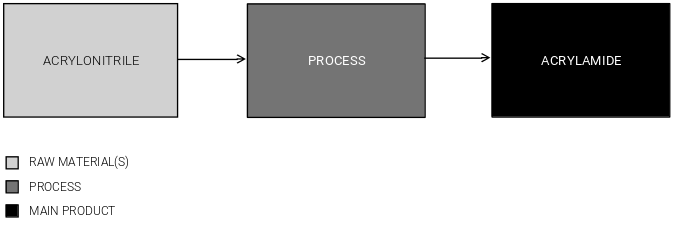Commodity Production Costs Report
Acrylamide Production
Acrylamide Plant Capital & Operating Cost Analysis | United States | Q3 2025
This report presents the economics of Acrylamide production from acrylonitrile. The process examined is an enzymatic hydration technology.
The report provides a comprehensive study of Acrylamide production and related Acrylamide production cost, covering three key aspects: a complete description of the Acrylamide production process examined; an in-depth analysis of the related Acrylamide plant capital cost (Capex); and an evaluation of the respective Acrylamide plant operating costs (Opex).
The Acrylamide production process description includes a block flow diagram (BFD), an overview of the industrial site installations, detailing both the process unit and the necessary infrastructure, process consumption figures and comprehensive process flow diagrams (PFD). The Acrylamide plant capital cost analysis breaks down the Capex by plant cost (i.e., ISBL, OSBL and Contingency); owner's cost; working capital; and costs incurred during industrial plant commissioning and start-up. The Acrylamide plant operating costs analysis covers operating expenses, including variable costs like raw materials and utilities, and fixed costs such as maintenance, labor, and depreciation.

Product
Acrylamide. Acrylamide is a chemical used to produce polyacrylamide polymers, serving as flocculants in water treatment and additives in the paper and mining industries. It enhances particle aggregation for improved solid-liquid separation. Acrylamide is produced by the hydration of acrylonitrile and is stored as a solid or aqueous solution. Its applications extend to soil conditioning and enhanced oil recovery due to its viscosity-modifying properties.
Raw Material
Acrylonitrile. Acrylonitrile is a molecule having a carbon-carbon double bond conjugated with a nitrile group. It is a very reactive compound, since it is polar (due to the presence of the nitrogen heteroatom) and unsaturated. Currently, acrylonitrile is mainly produced by the ammoxidation of propylene and by the ammoxidation of propane. Both processes generate acetonitrile and hydrogen cyanide as by-products. As a highly reactive chemical, acrylonitrile serves as an intermediate to produce a range of chemicals, including antioxidants, pharmaceuticals and especially polymers. Due to the possibility of spontaneous polymerization in the presence of strong alkali or when exposed to light, high-purity acrylonitrile product must be stored or transported with polymerization inhibitors. Storage tanks or containers may be constructed with carbon or stainless steel.
Report in PDF Format
Download & Explore Anytime
Access in Various Devices
Print & Read Comfortably
Share With Co-workers
Up-to-date Report
Professional report based on Q3 2025 economic data, ensuring timely evaluations.
Multiple Use Cases
Ideal for investment screening, feasibility studies, cost estimates, and research planning.
Proven Methodology
Developed using a consistent methodology honed over a decade, ensuring reliable cost analyses.
Report Editions
Content Highlights
Plant Capital Cost Summary
Summary outlining the capital cost required for building the Acrylamide production plant examined.
Plant Capital Cost Details
Detailing of fixed capital (ISBL, OSBL & Owner’s Cost), working capital and additional capital requirements.
Plant Cost Breakdowns
Breakdown of Acrylamide process unit (ISBL) costs and infrastructure (OSBL) costs; plant cost breakdown per discipline.
Operating Costs Summary
Summary presenting the operating variable costs and the total operating cost of the Acrylamide production plant studied.
Operating Cost Details
Detailing of utilities costs, operating fixed costs and depreciation.
Plant Capacity Assessment
Comparative analysis of capital investment and operating costs for different Acrylamide plant capacities.
Production Process Information
Block Flow Diagram, descriptions of process unit (ISBL) and site infrastructure (OSBL).
Process Consumptions
Raw materials and utilities consumption figures, by-products credits, labor requirements
Process Diagrams
Process flow diagrams (PFD), equipment list and industrial site configuration
Could Not Find the Report You Need?
Obtain a Bespoke Report
Get a report targeting the process in which you are interested
See Offer Details
Understand Bespoke Reports and how you can easily order them
Check Editions & Pricing
Complete a brief form and see a quotation for your Bespoke Report
Other Related Production Cost Reports

Acrylonitrile Production from Propane
This study presents the economics of Acrylonitrile production via propane ammoxidation. The process is similar to the one proposed by PTT Asahi Chemical (PTTAC), consisting in the reaction of propane with ammonia, producing Acrylonitrile. Acetonitrile and hydrogen cyanide are produced as by-products. The analysis assumes a plant located in the United States,
Details: 200 kta United States-based plant | Q3 2025 | 107 pages | Issue B | From $799 USD

Acrylonitrile Production from Propylene (Fluidized Bed Ammoxidation)
This report presents the economics of Acrylonitrile production from chemical grade (CG) propylene in the United States. The process reviewed is a propylene ammoxidation technology using fluidized bed reactor, in which propylene reacts with ammonia, producing Acrylonitrile, and generating acetonitrile and hydrogen cyanide as by-products.
Details: 300 kta United States-based plant | Q3 2025 | 107 pages | Issue A | From $799 USD

Polyacrylamide Production
This report analyses the economics of Polyacrylamide Powder production from acrylamide in the United States.
Details: 30 kta United States-based plant | Q3 2025 | 107 pages | Issue A | From $3,900 USD
+800 Reports Developed, Targeting +250 Commodities
Vast Report Library
858 independent and up-to-date reports examining embryonic and established production processes.
Free Sample Reports
Quickly understand the structure and depth of content of our professional reports.

